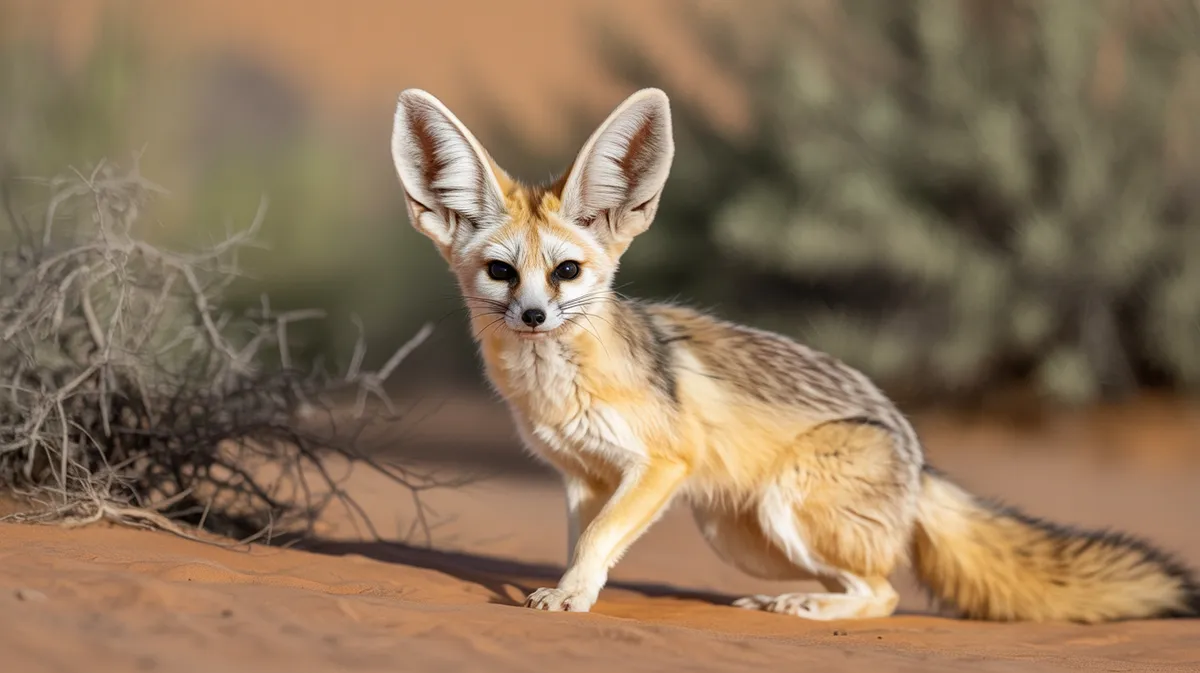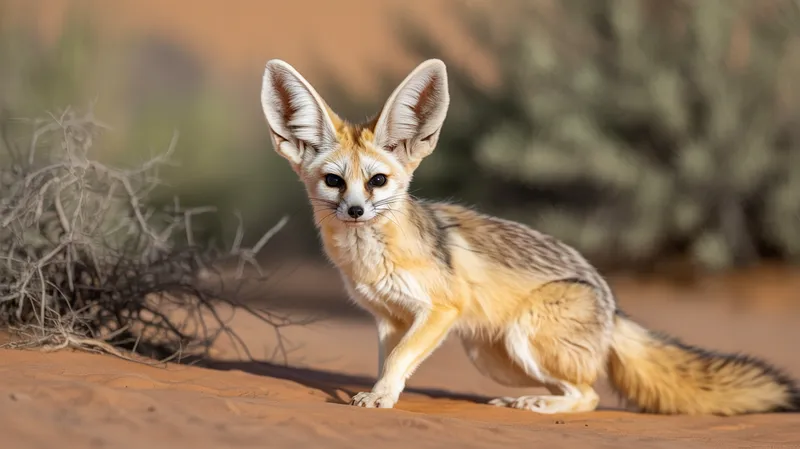
Fennec Fox
Vulpes zerda

Meet the Fennec Fox
The Fennec Fox is a small, nocturnal fox native to the Sahara Desert and other arid regions of North Africa. Recognized by its enormous ears, which can be half as long as its body, this fox uses them to dissipate heat and detect prey underground. Its sandy-colored fur provides excellent camouflage and insulation against both the desert heat and cold nights. Fennec Foxes are highly social animals, living in family groups and exhibiting remarkable adaptations for desert survival.
Classification
Mammal
Habitat
Desert
Diet
Omnivore
Lifespan
10–14 years
Conservation
Least Concern
Weight
0.8–1.5 kg
📖Fascinating Facts
Tiny Desert Dwellers
Fennec Foxes are the smallest species of fox in the world, with adults weighing as little as 0.8 kg.
Super Sonic Hearing
Their oversized ears can detect insects and small animals moving underground, making them expert hunters.
Masters of Conservation
These foxes can go for long stretches without drinking water, relying on plant matter and prey for hydration.
📋Detailed Description
The Fennec Fox (Vulpes zerda) is the smallest canid species, with adults typically weighing between 0.8 and 1.5 kg (1.8–3.3 lbs) and measuring 24–41 cm (9–16 in) in body length, excluding the bushy tail which adds another 18–31 cm (7–12 in). Its most distinctive feature is its disproportionately large ears, which can reach up to 15 cm (6 in) in length—about 40% of its head-body length. These ears serve both as radiators to dissipate excess body heat and as highly sensitive detectors of prey movement underground. The fennec's dense, pale cream to sandy-colored fur reflects sunlight by day and provides insulation against cold desert nights, while fur-covered feet protect against hot sand. Its eyes are large and dark, adapted for nocturnal activity. The fox's slender build and agile limbs allow it to dig rapidly, creating complex burrow systems for shelter and thermoregulation. Fennec foxes are highly social, typically living in family groups of up to 10 individuals, and communicate through a range of vocalizations, scent markings, and body language. Their omnivorous diet includes insects, small vertebrates, fruits, roots, and eggs, enabling them to thrive in harsh, resource-scarce environments. The species is well-adapted to arid habitats, requiring minimal free water due to highly efficient kidneys and the ability to extract moisture from food.
💡 Did you know?
A Fennec Fox’s ears can grow up to 15 centimeters (6 inches) long, helping them not only hear prey, but also regulate body temperature.
🔬Research & Sources
Wikipedia Summary
The fennec fox is a small fox native to the deserts of North Africa, ranging from Western Sahara and Mauritania to the Sinai Peninsula. Its most distinctive feature is its unusually large ears, which serve to dissipate heat and listen for underground prey. The fennec is the smallest fox species. Its coat, ears, and kidney functions have adapted to the desert environment with high temperatures and little water.
Last Modified: 5/31/2025
🎭Behavior & Social Structure
Fennec foxes are primarily nocturnal, emerging from their burrows at dusk to avoid the extreme daytime heat. They exhibit crepuscular and nocturnal foraging patterns, relying on acute hearing to detect insects, rodents, lizards, and other prey beneath the sand. Their diet is opportunistic and seasonally variable, often supplemented by fruits and roots, which provide vital hydration. Fennec foxes are skilled diggers, capable of excavating burrows up to 120 square meters (1,300 sq ft) in area, with multiple entrances for escape and ventilation. Socially, they form monogamous pairs or small family groups, with cooperative behaviors such as mutual grooming and food sharing. Territorial boundaries are marked with urine and feces, and vocalizations range from barks and growls to high-pitched yelps, especially during the breeding season or in defense of territory. Play behavior is common among juveniles and adults, strengthening social bonds.
👶Reproduction & Life Cycle
Fennec foxes are generally monogamous, with breeding pairs forming stable bonds. Mating typically occurs between January and March, though timing may vary regionally. After a gestation period of approximately 50–52 days, females give birth to litters of 2–5 kits (occasionally up to 6). Births occur in well-protected burrows, and the kits are born blind and helpless, opening their eyes after about 10 days. Both parents participate in rearing, with the male providing food while the female remains with the young during the early weeks. Weaning occurs at around 61–70 days, and juveniles begin to leave the den at about 3–4 weeks old. Sexual maturity is reached at 9–11 months, and dispersal from the natal group may occur in the first year.
🛡️Adaptations & Survival
The fennec fox exhibits a suite of adaptations for desert survival. Its large ears not only enhance auditory acuity for detecting prey but also facilitate thermoregulation by dissipating excess body heat. The pale, dense fur reflects sunlight and insulates against temperature extremes, while furred footpads protect against hot sand and aid in silent movement. Highly efficient kidneys concentrate urine, minimizing water loss, and the fox can survive for extended periods without direct water intake, relying on metabolic water from prey and plant matter. Behavioral adaptations include nocturnality to avoid daytime heat and burrow construction for shelter and temperature regulation. Social cooperation within family groups aids in territory defense and resource sharing.
📚Research Sources
🎨Cultural Significance
The fennec fox holds a notable place in North African folklore and culture, often symbolizing cleverness, adaptability, and survival. Its image appears in Berber and Tuareg stories as a trickster or wise animal. In modern times, the fennec fox has become a national symbol of Algeria and is featured in local art and literature. Its distinctive appearance has led to its popularity in the exotic pet trade and as a mascot in various media, though this has raised ethical and conservation concerns.
🔬Recent Research & Discoveries
Recent research on the fennec fox has focused on its physiological adaptations to aridity, including studies of renal function and thermoregulation. Genetic analyses have clarified its phylogenetic placement within the Vulpes genus, supporting its status as a distinct species. Ongoing ecological studies are examining population densities, home range sizes, and the impact of human activities on distribution. There is increasing interest in the fennec's role as an indicator species for desert ecosystem health. Conservationists are also investigating the effects of the pet trade and developing community-based strategies to reduce illegal capture.
🎥Wildlife Videos

Discovering the Smallest Wild Dog in the Vast Sahara
Over the course of filming "Dogs in the Wild", the filmmakers learned that not all wild dogs are easy to film. Please LIKE and ...
Nature on PBS

FENNEC FOX is the Cutest Wildlife Predator. The Smallest FOX in the world! Desert Fox
FENNEC is the Cutest Wildlife Predator. The Smallest FOX in the world! Desert Fox A night hunter with big ears and incredibly ...
WILDOPEDIA

Fennec Foxes: Tiny, Adorable, and Built for Extreme Heat | Animals Planet HD
Fennec Foxes: Tiny, Adorable, and Built for Extreme Heat | Animals Planet HD Description: Meet the Fennec Fox – The Desert's ...
Animals Planet HD

Wildlife of the Desert | 4K Ultra HD
Discover the enchanting world of desert wildlife with a spotlight on the adorable fennec fox! In this immersive exploration, we ...
Planet Pulse Expeditions

Fennec Fox - The Cutest Predator on Our Planet
Fennec Fox - The Cutest Predator on Our Planet I'm sure you've seen this animal before online. And probably the first thing that ...
WildFacts

Cute Animal Moments - Fennec Fox, Leopard, Otter, Ocelot, Squirrel,... - Animal Videos
Cute Animal Moments - Fennec Fox, Leopard, Otter, Ocelot, Squirrel,... - Animal Videos https://youtu.be/OXj9ReDNzSw As we ...
Relaxing Nature In 4K
🌍Habitat Information
The Fennec Fox typically inhabits Desert environments. Fennec Foxs have adapted to their environments with specialized features and behaviors.
Primary Habitat:
Desert
More detailed habitat information will be available soon.
🛡️Conservation Status
The Fennec Fox is currently classified as Least Concern. Conservation efforts are crucial for preserving this species for future generations.
Common Threats:
- 🏠Habitat loss and fragmentation
- 🌡️Climate change impacts
- 🎯Hunting and poaching
- 🏭Human-wildlife conflict
⚠️Threats & Conservation Challenges
While the fennec fox is currently listed as Least Concern by the IUCN, it faces localized threats from habitat degradation, human encroachment, and the illegal pet trade. In some regions, fennec foxes are hunted for their fur or captured for sale as exotic pets, which can impact local populations. Overgrazing by livestock and expansion of agriculture reduce available habitat and prey base. Despite these pressures, the species' wide range and adaptability have helped maintain stable overall populations, though ongoing monitoring is recommended to detect emerging threats.
🔬Scientific Classification
Scientific Name
Vulpes zerda
Classification Hierarchy
🔍 About Taxonomic Classification
Taxonomic classification is a hierarchical system used by scientists to classify and organize living organisms based on shared characteristics and evolutionary relationships.
The system moves from broad categories (Kingdom) to increasingly specific ones, with each animal's scientific name typically consisting of its Genus and species.
📝Community Notes
Share your observations and insights about the Fennec Fox with our community of wildlife enthusiasts.
Join Our Community
Sign in to share your observations and connect with fellow wildlife enthusiasts.
Sign In to ContributeNo community notes yet
Be the first to share your observations about the Fennec Fox!
Explore Fennec Fox
Select a tab above to learn more about this amazing animal.
📸Photo Gallery
No photos available for this animal yet.
🌟Discover More Wildlife
Continue your journey of discovery with more fascinating animals from our database
